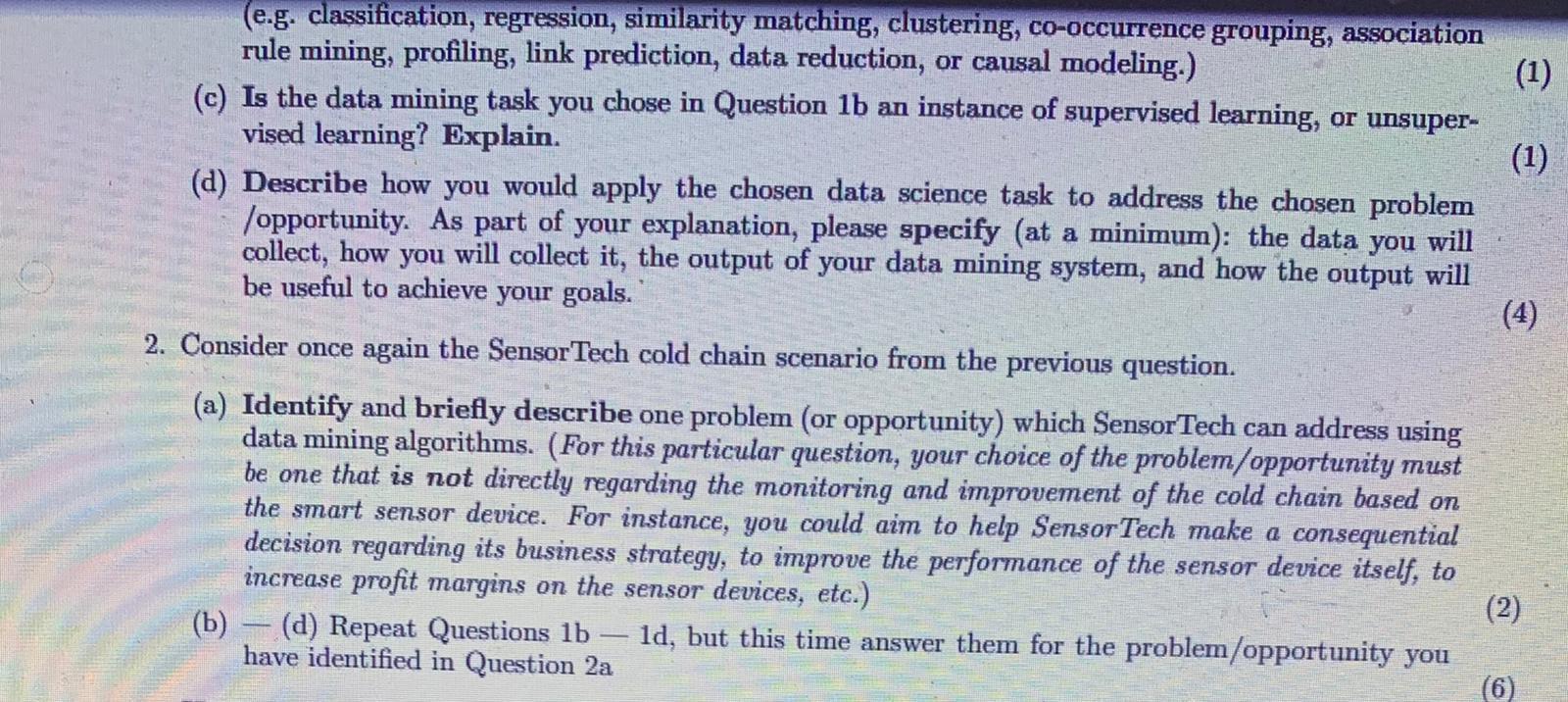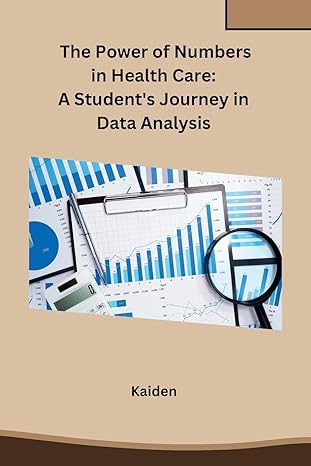


Points 1. Many vaccines, and other pharmaceutical drugs, must be continually stored within a particular tem- perature range in order to preserve their efficacy. This produces logistical challenges in distributing them to healthcare providers across the country, a type of supply chain problem called a cold chain. For example, the Pfizer COVID-19 vaccine must be stored at a temperature between -112F and -76F (-80C to -60C), which is colder than an average winter's day in Antarctica (-76F = -60C right at the South Pole). The Moderna COVID-19 vaccine must be stored at a temperature between -13F and 5F (-20C to -15C). Suppose that you work for Sensor Tech, a company which has been contracted by the US government to build a smart temperature and humidity monitoring device, with sensors and built-in predictive analytics algorithms to detect and prevent cold chain violations, and to help improve the efficiency of the supply chain in terms of cost, energy usage, and so on. The system will be deployed for monitoring and improving the cold chain for COVID vaccines, and will later be deployed for other vaccines and pharmaceutical drugs in the future. (2) (a) Identify and briefly describe one (1) problem (or opportunity) which Sensor Tech can ad- dress using data mining algorithms. (For this particular question, your choice of the prob- lem/opportunity must be one that is regarding the monitoring and improvement of the cold chain based on the smart sensor device.) (b) Identify a data mining task which could be used to address the problem you chose in Question la (e.g. classification, regression, similarity matching, clustering. co-occurrence grouping, association rule mining, profiling, link prediction, data reduction, or causal modeling.) (c) Is the data mining task you chose in Question lb an instance of supervised learning, or unsuper- vised learning? Explain. (d) Describe how you would apply the chosen data science task to address the chosen problem opportunity. As part of your explanation, please specify (at a minimum): the data you will collect, how you will collect it, the output of your data mining system, and how the output will be useful to achieve your goals. (1) (1) 2. Consider once again the Sensor Tech cold ohnim your goals. (4) 2. Consider once again the Sensor Tech cold chain scenario from the previous question. (a) Identify and briefly describe one problem (or opportunity) which Sensor Tech can address using data mining algorithms. (For this particular question, your choice of the problem/opportunity must be one that is not directly regarding the monitoring and improvement of the cold chain based on the smart sensor device. For instance, you could aim to help Sensor Tech make a consequential decision regarding its business strategy, to improve the performance of the sensor device itself, to increase profit margins on the sensor devices, etc.) (b) (d) Repeat Questions 1b 1d, but this time answer them for the problem/opportunity you have identified in Question 2a (2) (6) (1) (e.g. classification, regression, similarity matching, clustering, co-occurrence grouping, association rule mining, profiling, link prediction, data reduction, or causal modeling.) (c) Is the data mining task you chose in Question 1b an instance of supervised learning, or unsuper- vised learning? Explain. (d) Describe how you would apply the chosen data science task to address the chosen problem opportunity. As part of your explanation, please specify (at a minimum): the data you will collect, how you will collect it, the output of your data mining system, and how the output will be useful to achieve your goals. (1) 2. Consider once again the Sensor Tech cold chain scenario from the previous question. (a) Identify and briefly describe one problem (or opportunity) which Sensor Tech can address using data mining algorithms. (For this particular question, your choice of the problem/opportunity must be one that is not directly regarding the monitoring and improvement of the cold chain based on the smart sensor device. For instance, you could aim to help Sensor Tech make a consequential decision regarding its business strategy, to improve the performance of the sensor device itself, to increase profit margins on the sensor devices, etc.) (b) (d) Repeat Questions 1b 1d, but this time answer them for the problem/opportunity you have identified in Question 2a (2) (6) Points 1. Many vaccines, and other pharmaceutical drugs, must be continually stored within a particular tem- perature range in order to preserve their efficacy. This produces logistical challenges in distributing them to healthcare providers across the country, a type of supply chain problem called a cold chain. For example, the Pfizer COVID-19 vaccine must be stored at a temperature between -112F and -76F (-80C to -60C), which is colder than an average winter's day in Antarctica (-76F = -60C right at the South Pole). The Moderna COVID-19 vaccine must be stored at a temperature between -13F and 5F (-20C to -15C). Suppose that you work for Sensor Tech, a company which has been contracted by the US government to build a smart temperature and humidity monitoring device, with sensors and built-in predictive analytics algorithms to detect and prevent cold chain violations, and to help improve the efficiency of the supply chain in terms of cost, energy usage, and so on. The system will be deployed for monitoring and improving the cold chain for COVID vaccines, and will later be deployed for other vaccines and pharmaceutical drugs in the future. (2) (a) Identify and briefly describe one (1) problem (or opportunity) which Sensor Tech can ad- dress using data mining algorithms. (For this particular question, your choice of the prob- lem/opportunity must be one that is regarding the monitoring and improvement of the cold chain based on the smart sensor device.) (b) Identify a data mining task which could be used to address the problem you chose in Question la (e.g. classification, regression, similarity matching, clustering. co-occurrence grouping, association rule mining, profiling, link prediction, data reduction, or causal modeling.) (c) Is the data mining task you chose in Question lb an instance of supervised learning, or unsuper- vised learning? Explain. (d) Describe how you would apply the chosen data science task to address the chosen problem opportunity. As part of your explanation, please specify (at a minimum): the data you will collect, how you will collect it, the output of your data mining system, and how the output will be useful to achieve your goals. (1) (1) 2. Consider once again the Sensor Tech cold ohnim your goals. (4) 2. Consider once again the Sensor Tech cold chain scenario from the previous question. (a) Identify and briefly describe one problem (or opportunity) which Sensor Tech can address using data mining algorithms. (For this particular question, your choice of the problem/opportunity must be one that is not directly regarding the monitoring and improvement of the cold chain based on the smart sensor device. For instance, you could aim to help Sensor Tech make a consequential decision regarding its business strategy, to improve the performance of the sensor device itself, to increase profit margins on the sensor devices, etc.) (b) (d) Repeat Questions 1b 1d, but this time answer them for the problem/opportunity you have identified in Question 2a (2) (6) (1) (e.g. classification, regression, similarity matching, clustering, co-occurrence grouping, association rule mining, profiling, link prediction, data reduction, or causal modeling.) (c) Is the data mining task you chose in Question 1b an instance of supervised learning, or unsuper- vised learning? Explain. (d) Describe how you would apply the chosen data science task to address the chosen problem opportunity. As part of your explanation, please specify (at a minimum): the data you will collect, how you will collect it, the output of your data mining system, and how the output will be useful to achieve your goals. (1) 2. Consider once again the Sensor Tech cold chain scenario from the previous question. (a) Identify and briefly describe one problem (or opportunity) which Sensor Tech can address using data mining algorithms. (For this particular question, your choice of the problem/opportunity must be one that is not directly regarding the monitoring and improvement of the cold chain based on the smart sensor device. For instance, you could aim to help Sensor Tech make a consequential decision regarding its business strategy, to improve the performance of the sensor device itself, to increase profit margins on the sensor devices, etc.) (b) (d) Repeat Questions 1b 1d, but this time answer them for the problem/opportunity you have identified in Question 2a (2) (6)









